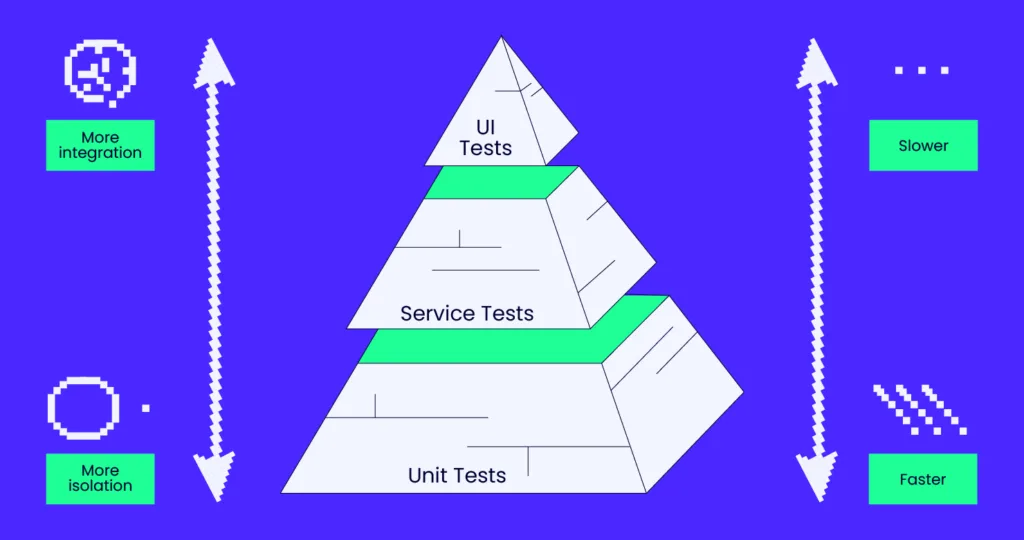
Blog
Importance of Software Testing for Software Development Process
- August 13, 2023
- 5:01 pm

In the world of software development, the quality and reliability of an application are essential to ensure its success in the market. Testing is one of the main ways to achieve these goals. They make it possible to verify that the application functions correctly and meets user expectations.
This article takes an in-depth look at the importance of software testing in an application, the different testing methodologies, their pros and cons, and some guidelines for writing your tests.
Table of Contents
Role of testing
Guarantee the quality of the product
The tests make it possible to ensure that the application meets the requirements defined beforehand in terms of functionalities, performance, and security. They also make it possible to detect and fix problems or bugs before the application is put into production, thus ensuring user satisfaction and project success.
Facilitate maintenance and evolution
By identifying problems in the early stages of development, testing facilitates the maintenance and evolution of the application. They also ensure that the changes made do not have undesirable effects on existing functionality (regressions), thus making the development process smoother and faster.
Reduce risk
Testing helps minimize the risks associated with bringing an application to the market. By detecting and resolving issues before release, testing helps avoid potential negative impact on company reputation and the costs of post-launch support and bug fixing.
Types of testing
1. Unit testing
Unit testing consists of verifying the proper functioning of the different code units or modules of the application. Generally functions or methods respecting a certain use case is tested.. These tests are carried out by the developers and make it possible to ensure that each component functions correctly in an isolated (unitary) manner.
2. Integration test
The integration test aims to verify that the various components of the application interact correctly with each other. These tests are generally carried out by test engineers or developers and allow the detection of problems related to the interaction between the different parts of the software testing services, for example: ensuring that when placing an order in an e- commerce, it passes all the validation steps, is created in the database and the user has received his order confirmation via a well-defined notification.
3. System testing
System testing consists of verifying that the application functions correctly as a whole, taking into account all the requirements and constraints of the system. These tests are generally carried out by test engineers and ensure that the application is ready to be deployed in production, e.g. ensuring that there is enough disk space, that third-party APIs are available and accessible, etc.
4. User Acceptance Testing
User Acceptance Testing (UAT) involves verifying that the application meets the expectations and needs of end users. These tests are generally carried out by representatives of the users (Business Analysts, Users or Product Owner), who validate the compliance of the application with respect to the functional and non-functional requirements. The requirements are defined during the project scoping phase or planned for the sprint in progress.
Sign up with ellow, access 25,000+ pre-vetted software developer profiles, and start building your software development team in 48 hours.
Benefits of Software Testing
1. Reduced costs and time
Detecting problems early through testing can significantly reduce the costs and time associated with fixing bugs. Indeed, it is usually easier and cheaper to correct a problem when it is discovered early in the development cycle.
3. Improved communication between stakeholders
Testing helps clarify the expectations and requirements of different project stakeholders, including developers, project managers, and customers. They facilitate communication and promote collaboration between team members.
4. Reducing Risk and Increasing Confidence
By ensuring that the application meets requirements and functions correctly, testing reduces the risks associated with launching and maintaining the application. They also help build customer and user confidence in product quality and reliability.
Disadvantages of Software Testing
1. Additional cost and time
Testing involves an investment of time and resources, which can be a drawback for projects with tight budgets and deadlines. However, it is important to consider the long-term benefits that testing brings in terms of application quality and reliability.
2. Limited test coverage
It is often difficult to test an entire application, in particular, due to the complexity of the interactions between the different components and the variety of possible use cases. This can lead to issues not detected during testing that will only be discovered in production.
3. False positives and false negatives
Tests can sometimes generate misleading results, such as false positives (incorrectly identifying a problem) or false negatives (not identifying an existing problem). These errors can make the testing process less efficient and require adjustments or additional checks, which is why it is always necessary to ensure that the tests are written correctly.
Test writing methodology
Clarity and simplicity
Writing clear and easy-to-understand tests is essential for easy maintenance and collaboration among team members. Each test should be concise and check only one aspect of the application. It is important to avoid complex and difficult-to-understand tests, which can lead to errors and make the testing process less efficient.
Explicit naming
The name of the tests should be self-explanatory and reflect the purpose of the test. A good test name makes it easy to understand what is being tested and makes it easier to find specific tests when needed. Using consistent and descriptive naming conventions improves test readability and maintainability.
Independence of tests
The tests must be independent of each other and not depend on the order of execution. This independence ensures that tests can be run in any order without risk of interference, making it easier to find and fix problems.
Automating
Test automation is essential to ensure an efficient and repeatable testing process. Automated tests can be run at any time quickly and reliably, helping to detect problems early and saving time during development and maintenance. Using appropriate testing tools and frameworks facilitates automation and helps reap the full benefits of testing.
Code coverage
It is important to strive for high code coverage when writing tests. Code coverage measures the proportion of the application’s source code that is executed during testing. High code coverage helps ensure that the majority of possible scenarios are tested and reduces the risk of undetected issues. However, it is also important not to focus only on code coverage, but to ensure that the tests are relevant and of high quality.
Regular and iterative testing
Testing should be done regularly and iteratively throughout the development process. This approach helps detect problems as early as possible and ensures that fixes are implemented quickly. Regular testing also helps to ensure that changes to the code do not affect existing functionality and to guarantee the quality and reliability of the application.
The test pyramid and cost management
The test pyramid is a model proposed by Mike Cohn, which illustrates the recommended distribution of the different types of tests in a software project. This pyramid highlights the relationship between the costs associated with each level of testing and can be used to better manage testing costs throughout the development lifecycle.

Source: theqalead.com
Unit tests (lower level)
These tests are designed to verify the smallest units of code, such as functions or methods. Unit tests are generally inexpensive to create and maintain, and they run quickly. They form the base of the pyramid and should be the most numerous tests in a software project.
Integration tests (intermediate level)
These tests focus on the interaction between the different components of the software and verify that the parts work correctly together. Integration tests are generally more expensive to set up and maintain than unit tests, and they also take longer to run. They should be fewer than unit tests, but still a key part of the testing strategy.
System and acceptance tests (higher level)
These tests verify that the entire system works properly and meets user expectations. They typically include manual testing, end-to-end automated testing, and performance testing. System and acceptance tests are typically the most expensive to implement and maintain, and they take the longest to run. System and acceptance tests are fewer in number than integration and unit tests.
The test pyramid suggests that organizations should invest more in unit testing, which is less expensive and faster to execute while maintaining a balance between integration testing and system and acceptance testing. This approach minimizes the costs and time associated with testing while ensuring adequate test coverage and high software quality.
The test pyramid can be used as a tool to guide testing strategy and effectively manage testing costs in a software project.
HTML, CSS, and JavaScript
You can create Android apps with HTML, CSS, and JavaScript using a tool called Adobe PhoneGap, which is powered by Apache Cordova. This tool helps you use your web skills to create hybrid apps. These apps look like regular apps but use something called “WebView” underneath.
While Adobe PhoneGap is fine for basic Android app tasks and mainly involves JavaScript, creating a good app takes a lot of effort. For a more solid standing as an Android developer, consider using other languages from this list.
If you’re familiar with JavaScript, you can explore React Native, an open-source framework in high demand. It allows the creation of beautiful and potent hybrid apps for both Android and iOS, aligning with the rising trend of hybrid app development, which can boost your software development career.
Advantages
- HTML, CSS, and JavaScript can be used to create apps that work on multiple platforms, reducing development time.
- Developers with web development experience can leverage their skills to create Android apps using familiar technologies.
- The Adobe PhoneGap framework lets you build hybrid apps, combining web and native app features.
- Utilizing existing web development skills for app creation can potentially reduce development costs and resource requirements.
HTML, CSS, and JavaScript might result in performance limitations and reduced access to native device features compared to fully native app development.
Conclusion
Writing quality tests is an essential part of ensuring the success of an application. By adopting a structured approach and following best practices, it is possible to write effective and relevant tests that help improve the quality, reliability, and maintainability of the application.
By considering clarity, simplicity, independence, automation, code coverage, and iterative approach, developers and test engineers can take full advantage of testing and ensure application success in the market.
To recap, here are some tips for writing your tests well:
- Write clear and simple tests, with a single objective per test.
- Use explicit and descriptive naming to make the tests easier to understand and find.
- Ensure test independence to avoid interference and execution order issues.
- Automate testing using appropriate tools and frameworks to ensure a fast and reliable testing process.
- Aim for high code coverage, while ensuring the relevance and quality of the tests.
- Perform testing regularly and iteratively throughout the development process to detect problems early and ensure application quality.
By following this advice and investing time and resources in testing, development teams can ensure the quality and reliability of their applications. This will not only improve user satisfaction but also reduce costs and time associated with bug fixing and maintenance.
Testing is therefore a key element for the success of a software project and deserves the attention and investment necessary to guarantee an optimal result.
Sign up with ellow, access 25,000+ pre-vetted software developer profiles, and start building your software development team in 48 hours.

Yokesh Sankar
I’m Yokesh Sankar, the COO at Sparkout Tech, one of the primary founders of a highly creative space. I'm more associated with digital transformation solutions for global issues. Nurturing in FinTech, supply chain, real estate, and other sectors vitalizing new-age technology, I see this space as a forum to share and seek information. Writing and reading give me more clarity about what I need.

Yokesh Sankar
I’m Yokesh Sankar, the COO at Sparkout Tech, one of the primary founders of a highly creative space. I'm more associated with digital transformation solutions for global issues. Nurturing in FinTech, supply chain, real estate, and other sectors vitalizing new-age technology, I see this space as a forum to share and seek information. Writing and reading give me more clarity about what I need.







